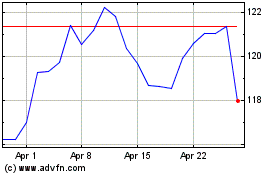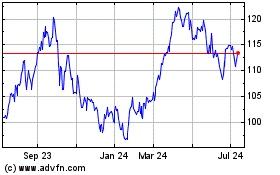By Christopher M. Matthews
Exxon Mobil Corp. posted its first quarterly loss in three
decades as it and rival Chevron Corp. painted a dismal picture of
the oil industry, signaling that the impact of the coronavirus
pandemic may hang over their businesses for much of 2020.
Exxon swung to a $610 million loss in the quarter as it took a
"market-related" $2.9 billion charge. It reported $2.4 billion in
profits during the same period last year. The bulk of the
impairment was related to its downstream business, which refines
oil into gasoline and other products.
Exxon Chief Executive Darren Woods said Friday the global
economic shutdown is putting unprecedented pressure on oil prices.
The largest U.S. oil company has cut $10 billion from its planned
capital expenditures in 2020, a 30% budget cut.
"Covid-19 has significantly impacted near-term demand, resulting
in oversupplied markets and unprecedented pressure on commodity
prices and margins," Mr. Woods said.
Exxon projected that it will reduce production by roughly
400,000 barrels a day in the second quarter, including around
100,000 barrels a day in the Permian Basin of Texas and New Mexico,
as a result of the new coronavirus.
Still, Mr. Woods said the company would continue to invest in
projects to increase future oil production. Exxon's oil output was
up slightly in the quarter, thanks to 9% increases in two of its
key projects: Guyana and the Permian Basin, the largest U.S. oil
field.
Chevron reported $3.6 billion in profits in the first quarter,
up 36% from the same period last year, but said it expects
financial results to fall later in the year due to the pandemic-led
oil-price crash.
The company projected it would reduce output by 200,000 to
300,000 barrels a day in May, and 200,000 to 400,000 in June.
Chevron also announced additional budget reductions, saying it
would cut capital expenditures by $2 billion on top of the $4
billion it had announced just weeks earlier. Chevron had planned to
spend $20 billion in 2020 before the virus took hold, but now says
it will likely spend $14 billion. It also said it expects operating
costs will decrease by $1 billion this year.
"The industry and the world are in a tough place right now,"
Chevron Chief Executive Mike Wirth said in an interview. "It feels
like we're bumping along a bottom for energy demand when we look at
the data. But it doesn't say it's going to snap back."
Earnings from Chevron's oil and gas production are already under
pressure, falling to $241 million from $748 million during the same
period last year. The company said it fetched $37 for a barrel of
oil during the quarter, down from $48 a year earlier. Overall
production of oil and equivalent liquids increased by 180,000
barrels a day from last year.
The global oil industry is facing an unprecedented challenges as
the coronavirus has sapped oil demand by as much as 30 million
barrels a day, roughly 30%.
Earlier this week, Royal Dutch Shell PLC cut its dividend for
the first time since World War II, upending what has long been a
fundamental bargain between oil majors and their investors, who
count on steady payments from the companies.
On Wednesday, Exxon signaled it may break its decadeslong run of
annual dividend increases, saying it would maintain current levels
in the second quarter. Chevron and BP PLC also didn't increase
their dividends.
BP reported a $4.3 billion loss in the first quarter as its debt
climbed to its highest levels since 2015, while Shell reported a
$24 million loss.
Major oil companies have moved quickly to reduce budgets as the
coronavirus spread globally. Investors have been scrambling to
figure out how much production each company will cut and when,
according to Kevin MacCurdy, an analyst for Heikkinen Energy
Advisors. The size of the cuts for each company could have huge
consequences, as those that don't have to cut as much could be
better positioned to capture rising oil demand as the virus
subsidies, he said.
"When it comes to production cuts, there will be winners and
there will be losers," Mr. MacCurdy said. "What's been released so
far is just the tip of the iceberg."
More than 600,000 barrels a day of production cuts have been
announced in the U.S., and consulting firm Rystad Energy forecasts
that U.S. output will fall from 12.8 million barrels a day in
January to 10.9 million a day in June and as low as 10.3 million a
day in September.
Chevron is among a group of companies that are negotiating
production cuts with oil-rich nations that have agreed to reduce
production. Russia, Saudi Arabia and the Organization of the
Petroleum Exporting Countries agreed in April to cut global output
by 13% or about 13 million barrels a day. About 15% of Chevron's
oil-equivalent production in 2019 occurred in the OPEC members of
Angola, Nigeria, the Republic of Congo and Venezuela.
"We're not immune to some of these realities," Mr. Wirth
said.
Despite the cuts, Mr. Wirth said he expected Chevron's annual
production to be roughly flat from last year, including in the
Permian.
While Exxon and Chevron are cutting hundreds of thousands of
barrels in the short-term, the volumes are proportionally smaller
compared with what smaller companies are being forced to cut.
Exxon's planned cuts amount to about 10% of its global oil
production. By contrast, some smaller shale companies are cutting
50% or more of their production.
For years, Exxon and Chevron have prioritized investing in
dividend increases and growing oil production. Those priorities are
now stressing their balance sheets, according to Goldman Sachs. The
bank estimates Exxon and Chevron will have added $53 billion and
$29 billion, respectively, between 2010 and the end of this year,
and said they should re-evaluate their capital allocation
policies.
While the first-quarter results were painful for the companies,
many analysts believe the next quarter could be even worse as the
full impact of the economic shutdown becomes clearer.
"I think the most likely scenario we see is things get a lot
worse before they get better," said Dan Pickering, founder of
energy-focused asset management firm Pickering Energy Partners.
Some are hoping the silver lining is that the virus spurs a
much-needed wave of consolidation in the U.S. oil industry, as
analysts predict there will be dozens if not hundreds of
bankruptcies. Exxon and Chevron could stand to benefit if they are
able to swoop in to buy companies that emerge vulnerable following
the crisis.
"We're certainly going to come out of this with a lot less
companies, and probably more diverse companies," said George R.
Ward, head of investment bank PJ Solomon's energy group.
Write to Christopher M. Matthews at
christopher.matthews@wsj.com
(END) Dow Jones Newswires
May 01, 2020 10:07 ET (14:07 GMT)
Copyright (c) 2020 Dow Jones & Company, Inc.
Exxon Mobil (NYSE:XOM)
Historical Stock Chart
From Mar 2024 to Apr 2024

Exxon Mobil (NYSE:XOM)
Historical Stock Chart
From Apr 2023 to Apr 2024
